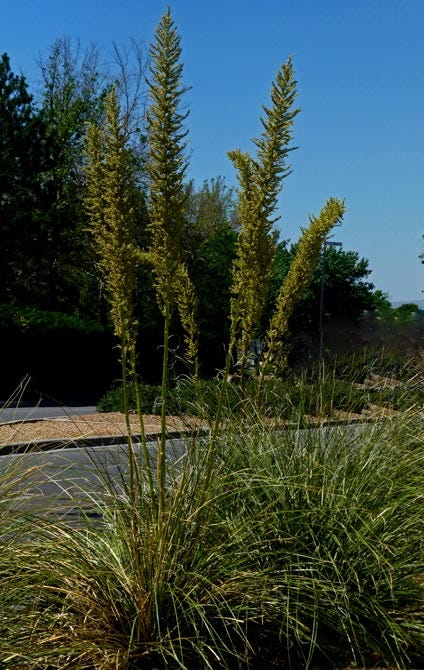by High Country Gardens

Two Cold Hardy Beargrass Species for Western Xeriscapes
The genus Nolina is a large family of woody succulents native to the Northern Hemisphere. There are 28 accepted species with most of them occurring in Mexico. In Mexico, these tough, xeric plants are often large, spectacular desert trees with swollen trunks (used for water storage). Over the border in the United States, we have two especially cold hardy species: Nolina texana (Texas Beargrass) and Nolina microcarpa (Big Beargrass or Sacahuista).
Don't mistake it for another "bear grass,” Xerophyllum tenax, a native plant from California, the Pacific Northwest, and the northern Rockies.
Long Lived, Low Care, Drought Resistant Plants
These little known native plants are extremely useful in our xeriscapes. Both beargrass species have tough, sharp-edged evergreen foliage that grows in a vase-shaped form giving them a grass-like appearance. Both species have unusual flower spikes that fill with small seeds in the fall. Texas Beargrass blooms down in the foliage, and Sacahuista has a tall flower spike (up to 8 ft.) that is a favorite perch to hummingbirds and songbirds. And best of all, both species are extremely drought resistant once established and will thrive with very little maintenance.

Cold Hardy and Grows Across Much of the Western U.S.
Over the many years I've lived in New Mexico, I've encountered Nolina texana across a surprisingly large area of the state, and found it in eastern New Mexico growing at elevations up to 7,000 ft. Beargrass from these higher elevation areas are cold hardy to at least USDA 5 (-20°F), and probably zone 4. Nolina microcarpa extends its range in western New Mexico into the high mountains along the Arizona-New Mexico border, where it endures the bone-chilling winters typical of USDA zone 6, although I strongly believe that established plants are even cold hardier to zone 5.
Utilizing the Many Advantages of Planting Nolina
Unfortunately, Nolina is most often used by itself in hot, dry patches of gravel, segregated from other plants. Instead of planting Nolina in a solitary space, I recommend that Beargrass is more widely used as a durable companion for cacti and succulents, low growing woody plants, and other drought resistant perennials. Use it as a medium-sized evergreen grass since the foliage of both species makes a three to four ft. tall mound of grass-like leaves.
- Companion Shrubs
-
I like to plant Beargrass in patches of low growing shrubs. Here are some suggested companion shrubs:
- Caryopteris (Blue Mist Spirea)
- Perovskia (Russian Sage)
- Rhus aromatica 'Gro-Low' (Gro-Low Sumac)
- Spreading Groundcover Junipers
- Companion Cacti and Succulents
-
Group Nolina with larger growing cacti and succulents. I would suggest the following:
- Echinocereus (Claret Cup) — E. triglochidiatus 'White Sands' (Giant Claret Cup)
- Ferocactus species (Giant Barrel Cacti)
- Yucca — Y. baccata (Banana Yucca) and Yucca faxoniana (Texas Tree Yucca)
- Agave (Century Plant) — A. havardiana (Havard's century plant) and A. parryi 'Flagstaff form' (Parry's Century Plant)
- Hesperaloe parviflora (Texas Red Yucca)
- Opuntia cacanapa 'Ellisiana' (Spineless Prickly Pear)

Nolina texana in full bloom. - Companion Flowering Perennials
-
Plant Beargrass with larger, heat loving perennials, such as the following:
- Penstemon (Beardtongue) — P. palmeri (Palmer's Beardtongue) and P. pseudospectabilis Coconino County (Coconino Country Desert Beardtongue)
- Salvia greggii and hybrids — S. Raspberry Delight®, S. greggii 'Furman's Red', and S. Ultra Violet
- Salvia dorrii (Purple Sage)
- Salvia pachyphylla (Giant Purple Sage)
- Agastache (Hummingbird Mint) — A. rupestris Glowing Embers®
- Companion Ornamental Grasses
-
Mix lower, mounding types of ornamental grasses around Nolina clumps. Below are some suggested companion grasses:
- Bouteloua gracilis 'Blonde Ambition' (Blue Grama Grass Cultivar)
- Muhlenbergia capillaris Regal Mist© (Pink Muhly Grass)
- Muhlengergia Pink Flamingo (Pink Flamingo Muhly Grass)
Text and Photos by David Salman.
© All articles are copyrighted by High Country Gardens. Republishing an entire High Country Gardens blog post or article is prohibited without permission. Please feel free to share a short excerpt with a link back to the article on social media websites, such as Facebook and Pinterest.